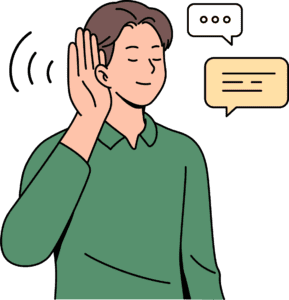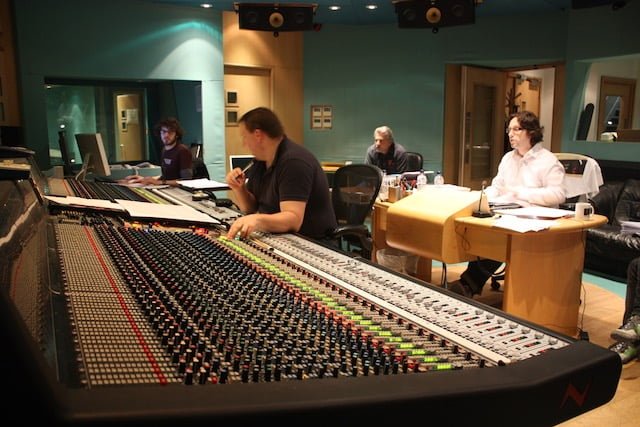Have you ever wondered about the complex interplay of sounds that create the perfect harmony in a musical piece, or the precise balance of audio in a movie soundtrack? Well, buckle up because we’re about to embark on a fascinating journey into the science of listening. This science is pervasive and essential, not just in daily human interaction but profoundly in professional domains such as music production, film soundtracks, live performances, and in the technical processes of mixing and mastering.

Whether it’s the pulsating drum-beats in a rock concert, the sonorous melodies of a symphony orchestra, the eerie silence in a suspenseful movie scene, or the streamlined blend of vocals and instruments in a pop song, every element is meticulously planned and executed. This brings us to the important aspect of our auditory perception – the ability to understand and interpret these sounds. And understanding often begins with improving our listening skills.
Listening is not only about hearing. It’s about decoding the sanctity of sounds, enabling us to understand, communicate, and, more importantly, appreciate the world of sound around us.
- Music Production: Producers employ their honed listening skills to create aural masterpieces, controlling the balance of various sounds, sculpting the raw sounds into a cohesive piece.
- Film Soundtracks: Film sound artists are sonic storytellers, creating an auditory realm that complements the visual experience, stirring emotions and heightening the overall movie experience.
- Live Performances: During live shows and acoustic performances, engineers and musicians use their astute listening skills to adjust sounds on-the-fly, ensuring that the audience gets an optimally balanced, engaging sonic experience.
- Mixing and Mastering: This is the fine art of balancing and enhancing recordings. Engineers use their deep listening skills to catch subtle nuances, managing different audio elements to give the final product a polished, professional sound.
So now that we’ve set the stage, let’s delve into the intricacies of auditory perception, and how you can fine-tune your own listening skills. Stay with us for an enlightening immersion into the world of sound and listening. You’re in for an auditory treat!
Auditory Perception
Auditory perception is a complex process that involves the brain’s ability to interpret and make sense of the sounds it receives from the ears. It is based on several key principles. The first principle is the perception of pitch, which is the highness or lowness of a sound. This is determined by the frequency of the sound waves, with higher frequencies perceived as higher pitches and lower frequencies as lower pitches.
The second principle is the perception of loudness. This is determined by the amplitude, or height, of the sound waves. The greater the amplitude, the louder the sound is perceived. However, our perception of loudness is also influenced by other factors, such as the duration and frequency of the sound.
Next, is the principle of timbre. Timbre, often referred to as the ‘color’ of the sound, is what allows us to distinguish between different sounds that have the same pitch and loudness. It is determined by the complex overtones of a sound and is the reason why a piano sounds different from a violin, even when they are playing the same note at the same volume.
Another principle is the perception of direction and distance. Our brains can determine the direction from which a sound is coming and how far away it is based on the slight differences in the time it takes for the sound to reach each ear. This is known as binaural hearing.
The Power of Active Listening
It was with some amusement that I learned from some graduate of the Royal College of Music, London, that my father had acquired notoriety for this catch phrase among the students: “You hear but you don’t listen”; it was a slight admonishment for some of the students.
I know from my own experience that years of practicing an instrument, honing your technique and playing all the notes at the right time and in tune, that the ability to hear yourself clearly and beyond, even for a technically brilliant virtuoso, is not a given. It takes ensemble training to learn how to listen to others while performing yourself, just as it takes a study of music theory to appreciate what it is that you are playing and why it works.
Only about 2% of people have had formal education on how to listen
Listening to music can be a great way to improve your listening skills. Try to focus on different elements of the music, such as the rhythm, melody, and lyrics. This can help to improve your ability to focus and pay attention to sounds.
Improving one’s listening skills can greatly enhance interpersonal communication. It allows for a deeper understanding of the messages being conveyed, fostering stronger relationships both in personal and professional settings.
Improving listening skills can also lead to increased empathy and understanding of others’ perspectives. By actively listening, one can better comprehend the emotions and experiences of others, fostering a more empathetic and compassionate worldview.
Training Your Ears for Better Sound Interpretation
Ear training is not the same as acquiring skill at playing an instrument. Most everyone can hear. But can you really listen? It doesn’t just apply to music, but also to what others say, or perhaps don’t even verbalize. It is a sensitivity that takes effort to develop. And how do you develop it?
Well, a couple of things. The acoustic environment has to allow the sound to reach your ears clearly. Music studios spend a lot of effort creating a neutral listening environment free of acoustic artifacts and external noise.
Also like education, it helps to have a mentor, someone who is standing before you asking the very basic questions — Can you hear that? Can you hear the difference? Do you understand that? This is true of language, logical argument, and active listening. We all need a teacher to point out the narrowness of our perspectives, and to open our minds, eyes and ears to the examination of our perceptions and instinctive conclusions.
Approximately 75% of oral communication is ignored, misunderstood, or quickly forgotten
The statistic we’ve just shared is rather alarming, isn’t it? But fear not. Realizing the need for change is the first stride towards improvement, and you’re already there! Now let’s arm ourselves with some handy tips to help polish your listening skills.
Responsive Listening: A Bridge to Understand
Listening is, in essence, an interactive process. It’s not just about soaking in the words; it’s about responding and engaging too. When we practice responsive listening, we make a conscious effort to fully understand and value what the speaker is saying. It’s about constructing that bridge of comprehension between you and the speaker.
The Art of Clarification
Understanding the spoken words sometimes can be as winding as navigating a maze. But there’s a valuable tool at your disposal – clarification. Don’t hesitate to request clarification if any part of the discussion is unclear to you. In fact, speakers will likely appreciate your engagement and your desire to understand their points fully.
Paraphrasing
One of the proven strategies to ensure you’ve grasped the essence of a conversation is paraphrasing. After listening to the speaker, try to translate their message into your own words. Paraphrasing ensures you’ve genuinely understood and internalized the information, rather than merely heard it.
Perceive the Unspoken Cues
Effective listening transcends the boundaries of spoken language. It’s also about deciphering non-verbal cues. Is the speaker gesturing actively? Do their facial expressions align with the emotion reflected in their words? By observing and understanding these non-verbal signals, we gain a more profound insight into the speaker’s true intentions and feelings.
Patience: A Virtue in the Realm of Listening
Sometimes, we rush others to get to their point quickly, or even worse, interrupt them. But real listening requires patience. Make an effort to lend your full attention and time to the speaker. This respectful approach can make their stories unfold naturally, leading to more meaningful, richer interactions.
Remember, improving your listening skills is a journey, not a race. As you begin to incorporate these techniques into your daily communications, you’ll see a noticeable improvement. Soon, you’ll be navigating the landscape of sound and meaning like a true auditory champion!
Exploring the Landscape of Sound: A Journey of Listening
The artist, whether a performer, composer – or mixing and re-recording engineer – has the job of deciding the path through the sound world that the audience’s ear should follow. They must decide what is foreground and what is background at any given time. Countless recordings and live performances of the same classical work exist precisely because different performers, conductors, together with recording engineers, shape a particular journey through a work for the ear, that highlights different aspects of the music. Musicians call it an “interpretation”.
While it is possible for a listener to choose to focus on different parts of the sound, e.g. different instruments in the crowd, essentially such an approach is to lean into the listening experience – rather than sit back – the latter being the more natural position of the audience, until they become specialized or particularly attuned to a specific work.
The performer, conductor, composer or director cannot guess what the lean-in listener chooses to focus on. Instead they can only shape what they hope will be the journey through the audio experience for the audience member who attends without expectations or pre-existing agenda.
So it is that artists, conductors, composers et alia must make hundreds of micro-decisions and also macro-decisions, about what is foreground and what is background, in rehearsal, in composing, or in the mixing room.

Re-recording mixing for film
When you dive into the sound world of a film, edited by gifted re-recording engineers, you will notice how the sound is constantly shaped, shifting between the multiple components in the sound mix, music, dialog, ambient sounds, in a way that tells a story, creates excitement and tension. Conflicting sounds and frequencies are carefully avoided. It is absolutely no good to put in multiple distracting sounds so that you aren’t sure which to listen to. It is the same with composing music – and also with mixing a recording of it. You have to decide which part to make clear at any given moment, and then you MUST make room for it.
Foreground vs background
When it comes to music and dialogue, a re-recording engineer must also have a sensitivity and sufficient understanding of the language. Not all parts of speech are equally important, leaving room to divert the ear to something else temporarily, but you need to understand the words and dramatic delivery well enough to appreciate that.
This understanding allows engineers to bring a unique narrative layer to their work by providing them with the ability to weave sonic threads with discretion. It’s like being the conductor of an unseen orchestra, creating a symphony of sounds that bolster the story’s emotional impact.
Specifically in the realm of cinema, balance forms an essential aspect of the re-recording engineer’s skillset. In the midst of dynamic chase scenes or intimate dialogues, they must carefully draw out the critical auditory elements while nestling the supporting sounds into the soundscape subtly.
The dialogues should be clear and distinct, allowing viewers to understand every word, while the background music and sound effects complement and amplify the onscreen action. It’s a careful balancing act, where the push and pull of various sound elements play an integral role in driving the narrative forward.
It’s crucial to remember that background sounds aren’t always secondary in importance. Sometimes, they act as an important character in the narrative, shaping the mood, context, or direction of the scene. As you embark on your journey to improve your listening skills, try to observe this delicate dynamic interaction in any form of audio-visual content.
Through the practice of attentive listening, not only can you appreciate the skill of re-recording engineers, but you can also absorb how they draw their listeners in, enveloping them in a rich, sonic cocoon that transcends the ordinary auditory experience. This practice empowers you to navigate the complex acoustic environments around you, honing your ability to pick out nuances and subtleties in the world of sound.
In conclusion, the path to mastering the craft of listening is deeply personal and transformative. By engaging actively with the sounds around you and truly absorbing their meaning, you can enrich your understanding of life and reshape the way you interact with the world. It’s a journey that embedded with challenges, yet fraught with opportunities to unlock untapped potential in the realm of auditory perception. Remember, every sound tells a story, the conversation is in the details. All it takes is an attentive ear, ready to listen, explore and unravel the serenades of sound that echo all around you. So go ahead, dive deep into the intriguing soundscape of life. Happy listening!



Pingback: The Unseen Orchestra: Decoding the Noises in Your Ear